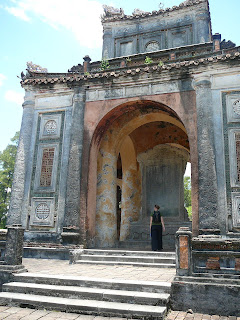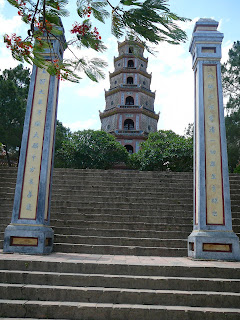
After meeting up with Alison and her friends and spending a couple days regrouping in Hanoi, we all signed up to take a tour to Halong Bay. For those of you who don't know, Halong Bay is the bay that springs to everyones mind when they think of Southeast Asian coastlines. Giant rocky islands rise from the water, their gray stone surfaces covered with lush green plant life.
Unfortunately, since Sarah and I leave for India on the 29th, and most of the rest of the gang heads on to other destinations on that same day, we only had time to make a one night trip.
So, the seven of us loaded into a van with our guide, driver, and a half dozen other travelers, and after a quick three hour drive (its odd that I think of 3 hours as "quick" these days), we'd arrived at the city of Halong.
Without wasting any time, the guide led the rest of us onto the large boat which would serve as both our mobile base camp and hotel for the next 24 hours. Following a steady stream of similar tour boats, we wound our way into the maze of Halong's islands.
 The gang boards the boat (Alison's taking the picture, not sure where Brian is).
The gang boards the boat (Alison's taking the picture, not sure where Brian is).They are, quite simply, stunning. As I said above, everyone has at least seen a picture of Halong Bay, its island seastacks stretching across the horizon and fading into the atmosphere (usually photographed at sunrise or sunset). But still, those photos can't quick prepare you for the reality of seeing the islands rising above you spreading out as far as the eye can see.
 Entering one of many channels in the Bay.
Entering one of many channels in the Bay.  Another tourist ship, or junk, sails by in front of the Halong horizon.
Another tourist ship, or junk, sails by in front of the Halong horizon. The unreal coastline of one of Halong's countless islands.
The unreal coastline of one of Halong's countless islands.After sitting on the deck and just admiring the view for an hour or so, our first stop was a massive cave in one of the islands. At first, I thought I would rather just stay on the boat and soak in the atmosphere, but the caves were actually very impressive. Huge and organic looking, illuminated by psychedelic lights, each chamber seemed larger and more impressive than the previous.
 The caves.
The caves.Plus, the cool cave air proved to be pleasant break from the hot and humid air which lurked outside.
After exploring the caved, it was time for some sea kayaking. And, lets just say that sea kayaking in Vietnam is an entirely different affair than sea kayaking in New Zealand. Before kayaking in New Zealand, the guide took us through roughly an hour or safety training, before loading us into our clean state-of-the-art kayaks. In Halong Bay, by contrast, the guide merely instructed us to "get in" before pushing us off to fend for ourselves.
Scrambling to follow after our guides kayak, he lead our group through a rocking tunnel and into a closed in inlet. Sitting in the middle of the inlet, Sarah and I stared around wide eyed at the rocks rising above us and the jungle sounds echoing down toward us. Sarah rightly observed: "I'm just trying to take it all in while I can."
After a short time there, it was back to our boat. We were then taken to a small sandy beach, where we were allowed to frolic for a short bit. Since it was actually getting late in the day, and starting to cool off (by Vietnam standards), Sarah decided to sit on the shore and talk with Alison. But, realizing I'd been in Vietnam for a month, and not gone swimming, I waded in for a short bit.

Back on the boat again, a few of the other guys in the group decided to dive off the edge of it. But, Sarah and I were happy at that point to just watch them. Then, it was on to dinner, and spending the rest of the evenig sipping beer, talking and relazing in the rooftop deck of our boat.
The boat only had a limited number of double bed rooms, but luckily Sarah and I got one. It was a small, yet charming corner room that was everything you could hope for in a tour like this.

Well, until the fan went out at 5am, and the slow morning heat started to creep in.
The next morning, we awoke early (partially because the heat) and ate breakfast. Then, the members of our tour lucky enough to be spending another night in Halong Bay split off from our group to do a trek.
The remainder of our group, plus a few new members that had been grafted on from another tour group, were then taken to another bay, where the boat anchored and we were allowed to spend an hour or so diving from the top of the boat.
Now, let me first start by saying that the boat is rather tall. And it's roof is easily two stories up. But, getting over our initial trepidation, Sarah and I decided to take the plunge. I mean, how often do you get the opportunity to jump off a Chinese-style junk into the emerald blue waters of Halong Bay, right?
Our first jumps both went well. Sarah jumping easily into the water with the casualness of someone who spent seven years working as a life guard. I followed, plunging into the water like a needle.
 Yay! Good jump honey!
Yay! Good jump honey!Encouraged by our first jump, we decided to do another. This time though, we decided to jump together. And Alison would take a picture. it would be the perfect piece to put in our blog: Sarah and I leaping from a boat together, the beauty of Halong Bay surrounding us. Below is the picture that Alison took, let me know if you notice anything wrong with it.

Let me first start by saying that the ledge we were jumping off was really slick. Let me follow up by saying that, when I hit the water, fifteen-odd feet below, I was effectively doing a reverse belly-flop. And, while it's obvious that I survived... let's just say it was a less-than-comfortable experience. Actually, the next picture probably conveys that better than words could:

Anyhow, we were done diving for the day.
Soon, we were back on land again. Our tour of Halong Bay sadly already over. Sarah and I both agreed that we could have easily spent at least another day there, and that it was truly one of the highlights of the trip.
Now, we are back in Hanoi. Tonight we celebrate Alison's Birthday (Happy Birthday Alison!), then tomorrow we take care of errands before heading out to India on Tuesday.






































